|
|
|
Primate Ecology and ConservationEditor: Eleanor Sterling, Nora Bynum, and Mary Blair
Techniques in Ecology & Conservation
Oxford University Press
2013
" The study of primate ecology and conservation has advanced rapidly in recent years. This practical volume brings together a group of distinguished primate researchers to synthesize field, laboratory, and conservation management techniques for primate ecology and conservation. The synthesis focuses on new and emerging field methods alongside a comprehensive presentation of laboratory and data analysis techniques, as well as the latest methods for determining conservation status and conservation management."
|
Buy from amazon.co.uk 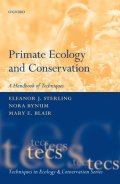
|
|
Carnivore Ecology and Conservation: A Handbook of TechniquesEditor: Luigi Boitani and Roger A. Powell
Techniques in Ecology & Conservation
Oxford University Press
2013
"This concise yet authoritative handbook describes research methods and techniques for the study and conservation of all terrestrial carnivore species. Particular attention is paid to techniques for managing the human/carnivore interface. Descriptions of the latest methodologies are supported by references to case studies, whilst dedicated boxes are used to illustrate how a technique is applied to a specific land cover type, species, or particular socio-economic context. The book describes the most recent advances in modelling the patterns of animal distributions, movements, and use of land cover types, as well as including the most efficient methods to trap, handle, and mark carnivores."
|
Buy from amazon.co.uk 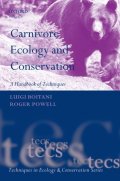
|
|
Remote Sensing for Ecology and Conservation: A Handbook of TechniquesNed Horning, Julie A. Robinson, Eleanor J. Sterling, Woody Turner and Sacha Spector
Techniques in Ecology & Conservation
Oxford University Press
2010
"The work of conservation biology has grown from local studies of single species into a discipline concerned with mapping and managing biodiversity on a global scale. Remote sensing, using satellite and aerial imaging to measure and map the environment, increasingly provides a vital tool for effective collection of the information needed to research and set policy for conservation priorities. The perceived complexities of remotely sensed data and analyses have tended to discourage scientists and managers from using this valuable resource. This text focuses on making remote sensing tools accessible to a larger audience of non-specialists, highlighting strengths and limitations while emphasizing the ways that remotely sensed data can be captured and used, especially for evaluating human impacts on ecological systems."
|
Buy from amazon.co.uk 
|
|
Marine Mammal Ecology and Conservation: A Handbook of TechniquesEditor: Ian L. Boyd, W. Don Bowen and Sara J. Iverson
Techniques in Ecology & Conservation
Oxford University Press
2010
"Marine mammals command a high level of public attention, reflected in specific legislation for their protection and management in many countries. They also present particular challenges to ecologists and conservation biologists. They are mostly difficult to observe, they occupy an environment that is vast in its three dimensional extent, there are often perceived conflicts between marine mammals and people, and furthermore several species are now close to extinction. Marine mammals have some intriguing features in their biology - the ability to dive to crushing depths, to perform breath-hold dives that defy our current understanding of mammalian physiology, and many have an ability to hunt down prey using sophisticated sonar that we are only just beginning to understand. Many species also have complex social structures. We still have much to learn about these extraordinary animals so a comprehensive and authoritative overview of current methodology is now timely. The intention of this book is both to summarize the state-of-the-art and to encourage innovation and further progress in this research field."
|
Buy from amazon.co.uk 
|
|
Invasive Species Management: A Handbook of Principles and TechniquesEditor: Mick N. Clout and Peter A. Williams
Techniques in Ecology & Conservation
Oxford University Press
2009
"Invasive alien species are a major and growing threat to biodiversity worldwide. The transport of organisms through increased levels of trade and tourism is leading to the widespread breaching of natural biogeographic barriers at unprecedented rates. Consequences can be severe, especially in naturally isolated ecosystems. Invasive alien species can cause the extinction of vulnerable endemic species, alter the structure and composition of communities, disrupt successional pathways, and lead to the loss of ecosystem services. Global climate change may further exacerbate the spread of alien species, as climatic zones shift and potential ranges alter. The effective management of invasive alien species is clearly a priority for biological conservation worldwide. This book first provides strategies for managing such species at successive invasion stages, from prevention at the border to control of major infestations. It then describes the general tools and approaches that are recommended for successful management of particular groups of invasive organisms in a range of environments. In each case, the ecological basis and practical requirements of invasive alien species management are addressed."
|
Buy from amazon.co.uk 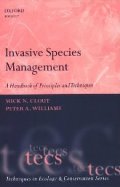
|
|
Insect Conservation: A Handbook of Approaches and MethodsMichael J. Samways, Melodie A. McGeoch and Tim R. New
Techniques in Ecology & Conservation
Oxford University Press
2009
"With up to a quarter of all insect species heading towards extinction over the next few decades, there is now a pressing need to summarize the techniques available for measuring insect diversity in order to develop effective conservation strategies. Insect Conservation outlines the main methods and techniques available to entomologists, providing a comprehensive synthesis for use by graduate students, researchers and practising conservationists worldwide. Both modern and more 'traditional' methodologies are described, backed up by practical background information and a global range of examples. Many newer techniques are included which have not yet been described in the existing book literature. This book will be particularly relevant to postgraduate and advanced undergraduate students taking courses in insect ecology, conservation biology and environmental management, as well as established researchers in these fields. It will also be a valuable reference for nature conservation practitioners and professional entomologists worldwide."
|
Buy from amazon.co.uk 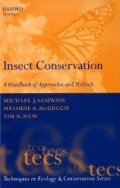
|
|
Amphibian Ecology and Conservation: A Handbook of TechniquesEditor: C. Kenneth Dodd Jr.
Techniques in Ecology & Conservation
Oxford University Press
2009
"This practical manual of amphibian ecology and conservation brings together a distinguished, international group of amphibian researchers to provide a state-of-the-art review of the many new and exciting techniques used to study amphibians and to track their conservation status and population trends. The integration of ecology and conservation is a natural outcome of the types of questions posed by these disciplines: how amphibians can and should be sampled, marked, and followed through time; how abundance and population trends are measured; what are the robust statistical methods that can be used in ecology and conservation; what roles do amphibians play in community structure and function; how do animals function in their environment; and what affects the long-term persistence of species assemblages? Although emphasizing field ecology, sections on physiological ecology, genetics, landscape ecology, and disease analysis are also included. The book describes the latest statistical approaches in amphibian field ecology and conservation, as well as the use of models in interpreting field research. Much of this information is scattered in the scientific literature or not readily available, and the intention is to provide an affordable, comprehensive synthesis for use by graduate students, researchers, and practising conservationists worldwide."
|
Buy from amazon.co.uk 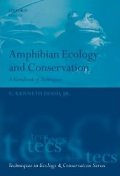
|
|
Habitat Management for Conservation: A Handbook of TechniquesMalcolm Ausden
Techniques in Ecology & Conservation
Oxford University Press
2007
"Habitat Management for Conservation is a practical handbook which describes the range of techniques used to manage land for biodiversity conservation. The opening sections discuss the general principles of habitat management, including decision-making, mitigating damaging effects of climate change, and monitoring the success of management. These are followed by a series of chapters which describe how to and shrublands, forests, woodlands and scrub, freshwater wetlands, coastal habitats, arable land, and gardens, backyards and urban areas. For each of these habitats the book discusses the main factors influencing their value for wildlife, highlights the key decisions that need to be made, and describes and compares the effects of individual management techniques. This comprehensive guide will be essential reading for graduate students and an invaluable resource for land managers, land-use advisors and others involved in conservation land management worldwide."
|
Buy from amazon.co.uk 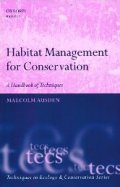
|
|
Forest Ecology and Conservation: A Handbook of TechniquesAdrian Newton
Techniques in Ecology & Conservation
Oxford University Press
2007
"Forest conservation has become one of the most important environmental issues currently facing humanity, as a result of widespread deforestation and forest degradation. Pressures on remaining natural forests continue to intensify, leading to high rates of biodiversity loss. Understanding how human activities influence ecological processes within forests is essential for developing effective conservation action. This book describes research methods and techniques relevant to understanding forest ecology, with a particular focus on those that are relevant to practical conservation and sustainable forest management. This information is currently disparate and difficult to locate and, as with other books in this series, the intention is to provide a comprehensive synthesis for use by graduate students, researchers and practising conservationists. Methods are presented for assessing forest extent and condition, structure and composition, and forest dynamics at a variety of scales. Techniques for assessing genetic variation and reproductive ecology, and for evaluating the habitat value of forests are also described. Particular emphasis is given to state-of-the-art techniques such as remote sensing, GIS, computer modelling and molecular markers. However, traditional methods of forest mensuration and ecological survey are also presented. The methods and techniques described are generally applicable to all forest types, including both temperate and tropical forest ecosystems."
|
Buy from amazon.co.uk 
|
|
Conservation and Sustainable Use: A Handbook of TechniquesE.J. Milner-Gulland and J. Marcus Rowcliffe
Techniques in Ecology & Conservation
Oxford University Press
2007
"The relentless exploitation and unsustainable use of wildlife, whether for food, medicine or other uses, is a key concern for conservationists worldwide. Indeed, wildlife conservation and sustainable use have recently become centrepieces in conservation and development research. Assessment, interpretation and ultimate action in a scientific study of exploited species must consider numerous factors: from the biology, habitat requirements and population dynamics of the species in question to the relationships that people have with their environment and the species within it. Any long-term management plan must ensure that people and wildlife can coexist - otherwise it is doomed to failure. Conservation and Sustainable Use provides a practical and integrated approach to carrying out research on the conservation of exploited species. It is relevant to both tropical and temperate biomes and is applicable to all exploited species, including mammals, fish and plants. It describes both the practical (field) and theoretical (modelling) techniques for obtaining and interpreting information, integrating biological, social, economic and institutional analyses. It also demonstrates how to translate information into effective action through appropriate interventions, from legislation to changing people's attitudes. This is the first time that all these issues have been covered together in a single, practically-orientated volume."
|
Buy from amazon.co.uk 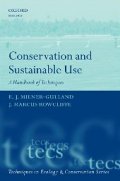
|
|
Conservation Education and Outreach Techniques: A Handbook of TechniquesSusan K. Jacobson, Mallory D. McDuff and Martha C. Monroe
Techniques in Ecology & Conservation
Oxford University Press
2006
"The conservation of biological diversity ultimately depends on people's knowledge and actions. This book presents the theory and practice for creating effective education and outreach programmes for conservation. Jacobson, McDuff, and Monroe describe an exciting array of techniques for enhancing school resources, marketing environmental messages, using mass media, developing partnerships for conservation, and designing on-site programmes for natural areas and community centres. Vivid case studies from around the world illustrate techniques and describe planning, implementation, and evaluation procedures, enabling readers to implement their own new ideas effectively."
|
Buy from amazon.co.uk 
|
|
Bird Ecology and Conservation: A Handbook of TechniquesWilliam J. Sutherland, Ian Newton and Rhys Green
Techniques in Ecology & Conservation
Oxford University Press
2004
"In this intensely practical handbook, a team of leading ornithologists describes a wide range of standard methods rhat can be applied to the study of avian ecology and conservation. Topics covered range from surveys, tracking and handling to breeding biology, foraging behaviour and migration. Chapters on conservation techniques describe how to assess species over-exploitation, the methods available for the intensive conservation of endangered species, and the principles involved in the maintenance and restoration of habitats. This comprehensive synthesis will be essential reading for graduate students and researchers as well as a valuable resource for environmental consultants and professional conservationists worldwide. Bird Ecology and Conservation is the first title in a new series of practical handbooks which include titles focusing on specific taxonomic groups as well as those describing broader themes and subjects."
|
Buy from amazon.co.uk 
|
|